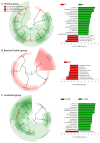Changes in Plasma Choline and the Betaine-to-Choline Ratio in Response to 6-Month Lifestyle Intervention Are Associated with the Changes of Lipid Profiles and Intestinal Microbiota: The ICAAN Study
- PMID: 34836260
- PMCID: PMC8625635
- DOI: 10.3390/nu13114006
Changes in Plasma Choline and the Betaine-to-Choline Ratio in Response to 6-Month Lifestyle Intervention Are Associated with the Changes of Lipid Profiles and Intestinal Microbiota: The ICAAN Study
Abstract
Trimethylamine N-oxide (TMAO) and its precursors, including choline, betaine, and L-carnitine, are gut microbiota-related metabolites associated with the risk of obesity. We aimed (1) to comprehensively examine whether the changes in plasma TMAO and its precursors induced by lifestyle intervention are associated with the improvements in plasma metabolic parameters; and (2) to identify the fecal microbiome profiles and nutrient intakes associated with these metabolites and metabolic index. Data from 40 participants (obese children and adolescents) having the plasma metabolites data related to the changes in BMI z-scores after 6-month lifestyle intervention were analyzed. In this study, we observed that choline and the betaine-to-choline ratio (B/C) showed different patterns depending on the changes in BMI z-scores by the response to lifestyle intervention. During the 6 months, an increase in choline and a decrease in B/C were observed in non-responders. We also found that changes in choline and B/C were associated with the improvements in plasma lipid levels. Individuals who showed reduced choline or increased B/C from the baseline to 6 months had a significant decrease in LDL-cholesterol over 6 months compared to those with increased choline or decreased B/C, respectively. In addition, the increase in choline or decrease in B/C was associated with the increase in plasma triglycerides. The distribution of gut microbiota belonging to the Firmicutes, such as Clostridia, Clostridiales, Peptostreptococcaceae, Romboutsia, and Romboutsia timonensis was altered to be lower during the 6 months both as choline decreased and B/C increased. Moreover, the decrease in choline and the increase in B/C were associated with reduced fat intake and increased fiber intake after the 6-month intervention. Finally, lower abundance of Romboutsia showed the association with lower LDL-cholesterol and higher intake of fiber. In summary, we demonstrated that reduced choline and increased B/C by lifestyle intervention were associated with the improvements of LDL-cholesterol and triglycerides, low-fat and high-fiber intakes, and low abundance of Firmicutes. These indicate that changes to circulating choline and B/C could predict individuals' changes in metabolic compositions in response to the lifestyle intervention.
Keywords: Firmicutes; betaine; choline; gut microbiota; metabolic parameters; metabolite.
Conflict of interest statement
The authors declare no conflict of interest.
Figures




Similar articles
-
Associations of plasma trimethylamine N-oxide, choline, carnitine, and betaine with inflammatory and cardiometabolic risk biomarkers and the fecal microbiome in the Multiethnic Cohort Adiposity Phenotype Study.Am J Clin Nutr. 2020 Jun 1;111(6):1226-1234. doi: 10.1093/ajcn/nqaa015. Am J Clin Nutr. 2020. PMID: 32055828 Free PMC article.
-
Whole egg consumption increases plasma choline and betaine without affecting TMAO levels or gut microbiome in overweight postmenopausal women.Nutr Res. 2020 Jun;78:36-41. doi: 10.1016/j.nutres.2020.04.002. Epub 2020 Apr 22. Nutr Res. 2020. PMID: 32464420 Clinical Trial.
-
Circulating gut microbiota metabolite trimethylamine N-oxide and oral contraceptive use in polycystic ovary syndrome.Clin Endocrinol (Oxf). 2019 Dec;91(6):810-815. doi: 10.1111/cen.14101. Epub 2019 Oct 6. Clin Endocrinol (Oxf). 2019. PMID: 31556132
-
The Role of a Gut Microbial-Derived Metabolite, Trimethylamine N-Oxide (TMAO), in Neurological Disorders.Mol Neurobiol. 2022 Nov;59(11):6684-6700. doi: 10.1007/s12035-022-02990-5. Epub 2022 Aug 20. Mol Neurobiol. 2022. PMID: 35986843 Review.
-
Dietary bioactive ingredients to modulate the gut microbiota-derived metabolite TMAO. New opportunities for functional food development.Food Funct. 2020 Aug 1;11(8):6745-6776. doi: 10.1039/d0fo01237h. Epub 2020 Jul 20. Food Funct. 2020. PMID: 32686802 Review.
Cited by
-
Moderate altitude exposure impacts extensive host-microbiota multi-kingdom connectivity with serum metabolome and fasting blood glucose.Virulence. 2025 Dec;16(1):2530660. doi: 10.1080/21505594.2025.2530660. Epub 2025 Jul 13. Virulence. 2025. PMID: 40631381 Free PMC article.
-
Shifts in Fecal Metabolite Profiles Associated With Ramadan Fasting Among Chinese and Pakistani Individuals.Front Nutr. 2022 May 3;9:845086. doi: 10.3389/fnut.2022.845086. eCollection 2022. Front Nutr. 2022. PMID: 35600819 Free PMC article.
-
Effects of the probiotic Lactiplantibacillus plantarum IMC 510® on body composition, biochemical parameters, gut microbiota composition and function, and clinical symptoms of overweight/obese subjects.Front Nutr. 2023 Apr 11;10:1142527. doi: 10.3389/fnut.2023.1142527. eCollection 2023. Front Nutr. 2023. PMID: 37125045 Free PMC article.
-
Choline Metabolites, Genetic Susceptibility, and Incident Heart Failure.JACC Adv. 2024 Dec 14;4(1):101445. doi: 10.1016/j.jacadv.2024.101445. eCollection 2025 Jan. JACC Adv. 2024. PMID: 39791104 Free PMC article.
-
Obesity-associated inflammation countered by a Mediterranean diet: the role of gut-derived metabolites.Front Nutr. 2024 Jun 24;11:1392666. doi: 10.3389/fnut.2024.1392666. eCollection 2024. Front Nutr. 2024. PMID: 38978699 Free PMC article. Review.
References
-
- Ejtahed H.S., Hasani-Ranjbar S., Larijani B. Human microbiome as an approach to personalized medicine. Altern. Ther. Health Med. 2017;23:8–9. - PubMed
MeSH terms
Substances
Supplementary concepts
LinkOut - more resources
Full Text Sources

